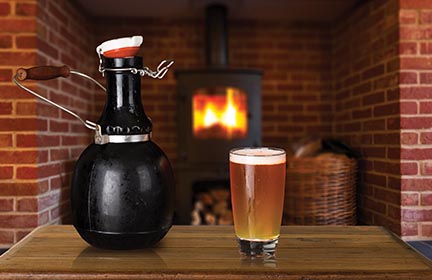Trending Articles ...
The Ever Changing Face of the U.S. Beer Business

Historians often urge caution when interpreting current events as being important and permanent because in the larger scheme of things, these events often play only a minor role. With the passage of time, a longer view can provide interesting and different perspectives. The changing face of the U.S. beer business is an example.
As of July, 2014, the number of brewing locations in the United States reached 3,040. This number isn’t as large as the 1873 record high of 4,131 breweries, but it is significantly greater than the 82 breweries active in 1980. It raises an interesting question; is this recent increase just a blip on the radar or a permanent change to America’s beer landscape?
Big Beer - Big Issues
As recently as the 1950s the domestic beer industry, although competitive, operated in a much friendlier way. When the Anheuser-Busch brewery in Newark, NJ operated a draft beer school, local rivals including Pabst, Schaefer, Rheingold and Ballantine were encouraged to have their employees attend. The goal was improve the image of beer and bring better and more consistent serving and storage techniques to bar patrons.
Today, our largest brewers are owned by foreign corporations and any semblance of friendliness is long since gone. Their only interests seem to be increases in sales, market share and profit. As the number of craft/micro/brewpubs continues to grow, headlines in the daily trade publications talk about how these new entities are chipping away at big beers sales. This is certainly big news, but it wasn’t long ago that industry pundits in the 1950s were writing about how Philip Morris’ upstart Miller Brewery and its CEO John Murphy were nipping at the heels of #1 Anheuser-Busch. Murphy, a lawyer turned marketing pro, was able to take Miller from being the 7th place brewer to the #2 spot in short order. He revolutionized the business with the introduction of Miller Lite – the first nationally available low calorie light beer. Murphy clearly understood the power of advertising and further understood that in order to grow his company he would need a portfolio of products that would appeal to different segments of the population. Unfortunately for Murphy and Miller, a story appeared in a national news magazine about Murphy wiping his feet on a rug he kept under his desk which was emblazoned with the Anheuser-Busch corporate logo. Chutzpah and ego had awakened a sleeping giant. The beer wars were on!
Russell Cleary, another lawyer, turned G. Heileman from a small Wisconsin based brewery into a rapidly rising #3. He took a non-traditional route to growing the company. Instead of building brands and introducing new products, he expanded his company by acquiring nearly a dozen regional brewers. Cleary and Heileman were on a roll, but they were stymied when Australian Alan Bond purchased a large block of stock, and was able to gain control of the company. Bond himself was then undone when he took on an unacceptable level of risk by relying on junk bonds to fund his companies’ expansion. Heileman’s demise was caused by poor financial management practices and lost market share. The brewery was sold subsequently to the Stroh Brewery of Detroit, Michigan.
The management of the Stroh Brewery committed at least two significant errors. First, they purchased two badly damaged breweries. One was the once mighty Schlitz Brewery and the other was a much weakened G. Heileman Company. Schlitz was burdened with debt and self-inflicted wounds when management made a fateful decision to save money by shortening the brewing process. Consumers knew immediately the taste had changed and that it wasn’t the same beer. A second and fatal error was committed when management chose not to recall thousands of bottles of bad beer from the trade. In addition to the Schlitz debacle, Stroh also committed a grievous error that today continues to haunt other large domestic brewers. In a desperate move to chase sales volume, the brewer introduced 18 packs and 30 packs of cans at a price that guaranteed a consumer would get a free six pack. This strategy became an example of marketing folly rather marketing brilliance. In this case, Stroh became a victim of short term management thinking.
Milwaukee based Pabst was once a mighty brewery. Founded in 1844, it fell upon hard times due to poor marketing. The company was rescued temporarily from extinction in 1982 by financier Paul Kalmanovitz. He became interested in owning recognizable brand names that could produce lots of cash without additional investment. Kalmanovitz was disinclined to advertise and succeeded in further gutting an already weak marketing program. Pabst ceased to be a brick and mortar brewer and became a “virtual brewer,” relying on others to make its beer. Pabst would no longer be considered a serious player in the beer business because of its owner’s greed.
We can round out our tales of woe for the big brewers by acknowledging the 2006 takeover of Anheuser-Busch, the world’s largest brewer, by a much smaller but aggressive Belgian/Brazilian company named InBev. It’s too soon after the event to make final conclusions, but it now seems certain an American icon was lost because of shareholder self-interest. Other bits of unfinished business include the tie up between the South African Brewery and Miller Brewing and the alliance (a joint venture in legal terms) between Miller/Coors. Nor can we ignore Constellation Brands, who was already a heavy hitter in wine and spirits, and is now a big hitter in the beer business after its acquisition of a state of the art brewery in Mexico and the marketing rights to the Corona portfolio of beers in the United States.
Craft Brewing - Present and Future
So, arriving at the present day, how do the 3,000+ craft/micro/brewpubs fit into this historical journey? Certainly, from an historian’s perspective, it is much too early to arrive at definitive conclusions. But, there are some clear indicators of what could likely happen in the future.
To this point in time, achieving double digit sales increases seems to be a norm in the craft beer world. However, this level of performance will become increasingly more difficult to achieve in the future as competition for sales heats up not only with the large global brewers but also between other brewers in the craft segment. The current friendly, cooperative almost fraternal atmosphere between craft brewers will be in danger of becoming simply another footnote in U.S. beer history.
Other potential disruptions to the status quo appear likely as well. Until now, price competition between craft brewers has been almost non-existent. But, for growth reasons and possibly survival reasons, some of the craft brewers will try to gain a competitive edge through price differentiation. Just as with the big brewers, price promotions and discounting could well become an everyday selling practice by craft brewers and their distributors.
On the political front, important differences in philosophy between large craft brewers and smaller craft brewers will emerge based on their own particular business needs. Clearly, the potential exists for a wide schism to open within the craft beer community based on different size and differing approaches to legislative and regulatory interests. Although many craft brewers, regardless of size, are unhappy with existing state franchise laws that either limit or prohibit them from terminating distributors, they have different reasons for wanting to be allowed to change distributors more easily. Larger craft brewers will seek to change distributors to achieve a unified distributor footprint in a geographic area, but smaller craft brewers may feel compelled to make such changes because they are not getting the attention they need to have from their current distributor; in other words, they feel lost in a distributor’s brand portfolio.
Also, while special lower excise treatment is important to all craft brewers, it may be more important to one size group than the other. Smaller brewers may need special treatment for survival reasons but lower taxes can be an important profit multiplier for larger craft brewers. Regardless of their motives or philosophy, each side has only a limited amount of political capital vis a vis relationships they can use; it simply may not be possible for most of them to fight both battles. Sadly, it is a fact of life that one’s self – interest is, after all, more compelling and important than friendship.
“Unlocking shareholder value” is a business term currently in vogue. Simply put, it means a business isn’t worth more than its annual cash earnings until such time as the business gets sold. Presently, there has been only a trickle of sell offs and consolidations in the craft business, but a trend is beginning to develop as owners start to think about “cashing out.” Spending 365 days a year at the job and worrying 24/7, merely working for a weekly paycheck may not be enough for some owners, who will conclude it is better to call it quits than to continue to face an uncertain future.
A local Maryland lawyer named John Mitchell used to like to talk about “the horribles." He was referring to those unknown and unforeseen events or changes that can take place over which a businessman has no control and that could put him out of business. Today, the craft beer business has wide audience appeal, but its core customers are members of the fickle millennial generation. Let’s suppose one day, not long from now, some of these consumers are no longer satisfied with highly hopped IPAs, sour beer and beer laden with strange and non–traditional beer ingredients. They may simply want a session friendly beer that is less expensive and that can be shared with friends. Craft brewers are going to have to adjust and learn to produce satisfying lager beers.
A valuable lesson craft brewers should learn from failed large brewers is that in the overall scheme of things, making a consistently excellent product is key to survival. Hugh Sisson, the owner of Baltimore’s Heavy Seas Brewery, is an outspoken proponent of quality assurance versus quality control. Quality assurance practices need to be in place throughout the brewing process to ensure product integrity whereas quality control addresses problems after the fact.
In order to have good quality products, you need to have good quality people. The question craft brewers need to ask is whether there are enough educated and trained brewing professionals available to sustain the growth trends of the craft movement, or will its growth be stymied due to a lack of qualified brewing personnel.
It seems axiomatic that those businesses who have the gelt (financial resources) will be able to avoid the “horribles” and spend their way out of difficult situations. Many craft brewers are feeling the squeeze of rapidly increasing prices and the lack of available raw materials. Hops prices are at an all-time high and some hop varieties will not be available to smaller brewers because larger or more financially sound brewers have been able to lockup future crops through forward purchasing. Grain available for malting will likely become another issue for smaller brewers as some grain farmers are switching to corn, a more lucrative crop that can be used in making ethanol. If that’s not enough, abundant, good quality water is becoming a problem in the western part of the country.
The craft beer business is booming, but it is not without peril and nothing can be taken for granted. What the beer business will look like in twenty years is anybody’s guess. Some industry observers even believe the unthinkable could occur. That is, Anheuser-Busch InBev could buy out SAB/Miller.
Anyone have a good crystal ball they would like to sell?

